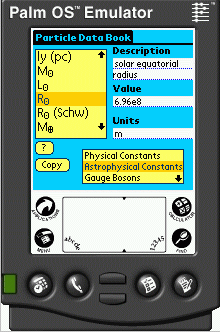Palm products from the Particle Data
Group
Warning: this page and the files
it points to are quite old.
They are not even tested on recent Palm
systems so use at your own risk.
We plan to update them in the fall of 2004.
The Particle Data Group is porting some of our databases and
information to the Palm computing environment. This is just a
beginning. We also give other physics related
links below. Keep those comments and suggestions flowing to
PDG consultant John
Krane (jkrane@fnal.gov)
or PDG contact Tom
Trippe (trippe@lbl.gov).
Particle Data Book, Palm Version 1.1
Doug Lowder
has contributed this Palm implementation of the Particle Physics
Booklet containing tables of physical and astrophysical constants,
and particle properties. Numerical values can copied/pasted into
Palm calculators. Download the file pdbook11.zip
(17KB), unzip it, and install the file pdbook11.prc on your Palm
device. This new version is a stand-alone application which includes
the data, so no separate database is needed.
See his Particle
Data Book page for more information and the same download
files.
Version 1.1, Sep. 19, 2001: Cures problems which caused crashes
and prevented beaming the application on Palm OS 4.0. |
 |
Other PDG Data and Figures
Table of Particle Masses, Widths, ID#'s
This is a table of all elementary particles, listing particle
name, charge, mass, width, and Monte Carlo Particle ID number.
Confidence level vs chi-squared/n and n d.o.f.
This figure gives contours of fixed confidence level as a function
of the "reduced chi-squared" (=chi-squared/n) and the
number of degrees of freedom n. Curves are labeled by the probability
that a measurement will give a value of chi-squared/n greater
than that given on the y axis; e.g. for n=10, a value of chi-squared/n
> 1.8 can be expected 5% of the time.
Confidence level vs chi-squared for n d.o.f.
This figure gives the confidence level versus chi-squared for
n degrees of freedom. The curve for a given n gives the probability
that a value at least as large as chi-squared will be obtained
in an experiment; e.g., for n=10, a value chi-squared >18 will
occur in 5% of a large number of experiments.
Downloading "Other PDG Data and Figures"
You can download the PDG's Palm
files (11KB), updated 9/99. Unzip the pdg_sep99.zip file, which
contains
|
File Name |
Contents (see also full descriptions below) |
Required App. |
|
chi2_n_vs_n.pdb |
Confidence level vs chi-squared/n and n d.o.f. |
Image Viewer III |
|
cl_vs_chi2.pdb |
Confidence level vs chi-squared for n d.o.f. |
Image Viewer III |
|
Part_DataG_v2.pdb |
Table of Particle Masses, Widths and ID#'s |
MobileDB Lite |
|
Part_DataG_v2_doc.txt |
Version history and notes for above Table |
any text reader |
Install the required application(s) for the file(s) you want
to use, and install the .pdb file(s) using the Install tool in
your Palm Desktop application.
Required Palm Application
MobileDB Lite is a free database
reader. Further information on this reader and the MobileDB shareware
reader used to create databases is available from Mobile
Generation Software.
Image Viewer
III is a shareware viewer for all kinds of bitmap images.
The free evaluation version works fine.
Other Physics
Related Applications
The Particle Data Group does not take responsibility for the
functionality of the following links, but provides them in case
you are interested:
Heavy Ion Fusion
Calculator (by Torben Lauritsen).
Last update July 13, 2000. Maintained by Tom
Trippe.
